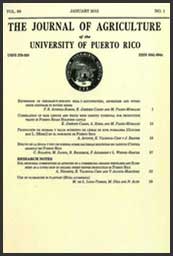Abstract
Different body dimensions were compared between 16 normally muscled (NM) and 16 heterocygous double muscled (DM) Senepol heifers. Body weight (BW), withers height (WH), hip height (HH), thorarcic perimeter (TP), barrel (BA), shoulder to pin bone distance (SPD), and the internal pelvic width (PW), height (PH), and area (PA) were recorded in each heifer. Also included were the relationships of BW/body dimensions, except for dimensions PW and PH. Data were analyzed by the GLIMMIX and CORR procedures of SAS. The respective genotypes MN and DM did not differ (P>0.10) in BW (415 and 434 kg), WH (both 113 cm), HH (both 120 cm), TP (both 175 cm), B A (209 and 214 cm), B W/B A (1.99 and 2.03 kg/cm), SPD (both 147 cm), PW (both 13 cm), PA (212 and 220 cm2), and BW/PA (1.96 and 1.98 kg/cm2). However, DM heifers tended to present (P<0.10) higher values than NM heifers for BW/WH, BW/HH, BW/SPD, and PH by margins of 0.14 kg/cm, 0.15 kg/cm, 0.12 kg/cm, and 0.59 cm, respectively. Moreover, the BW/TP value was 0.09 kg/cm greater (P<0.05) in the DM than in NM heifers. The correlations between different pairs of body dimensions were lower in the DM than in the NM heifers. These results suggest that the enhanced musculature visually observed in DM heifers must be accompanied by hypotrophy of other body organs and tissues, but not including the pelvic region. This compensatory effect minimizes the posibility of observing differences in body dimensions in vivo between DM and NM heifers.

